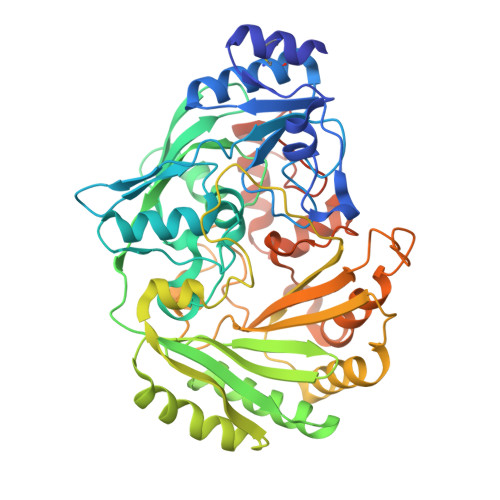Functional roles of the 6-S-cysteinyl, 8alpha-N1-histidyl FAD in glucooligosaccharide oxidase from Acremonium strictum
Huang, C.-H., Winkler, A., Chen, C.-L., Lai, W.-L., Tsai, Y.-C., Macheroux, P., Liaw, S.-H.(2008) J Biol Chem 283: 30990-30996
- PubMed: 18768475
- DOI: https://doi.org/10.1074/jbc.M804331200
- Primary Citation of Related Structures:
3HSU - PubMed Abstract:
The crystal structure of glucooligosaccharide oxidase from Acremonium strictum was demonstrated to contain a bicovalent flavinylation, with the 6- and 8alpha-positions of the flavin isoalloxazine ring cross-linked to Cys(130) and His(70), respectively. The H70A and C130A single mutants still retain the covalent FAD, indicating that flavinylation at these two residues is independent. Both mutants exhibit a decreased midpoint potential of approximately +69 and +61 mV, respectively, compared with +126 mV for the wild type, and possess lower activities with k(cat) values reduced to approximately 2 and 5%, and the flavin reduction rate reduced to 0.6 and 14%. This indicates that both covalent linkages increase the flavin redox potential and alter the redox properties to promote catalytic efficiency. In addition, the isolated H70A/C130A double mutant does not contain FAD, and addition of exogenous FAD was not able to restore any detectable activity. This demonstrates that the covalent attachment is essential for the binding of the oxidized cofactor. Furthermore, the crystal structure of the C130A mutant displays conformational changes in several cofactor and substrate-interacting residues and hence provides direct evidence for novel functions of flavinylation in assistance of cofactor and substrate binding. Finally, the wild-type enzyme is more heat and guanidine HCl-resistant than the mutants. Therefore, the bicovalent flavin linkage not only tunes the redox potential and contributes to cofactor and substrate binding but also increases structural stability.
Organizational Affiliation:
Department of Life Sciences, National Yang-Ming University, Taipei, Taiwan.



















